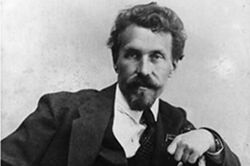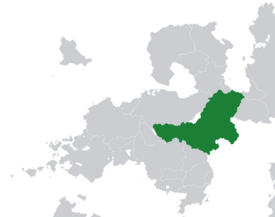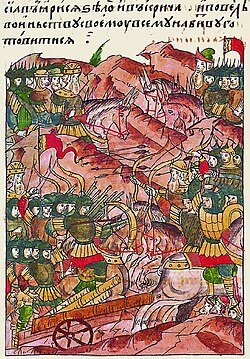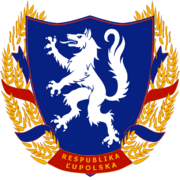User:Luepola/Vasarden archive: Difference between revisions
(Created page with "Archive of things from Vasarden that were, or are to be, overwritten by Regnum-oriented entries.") |
No edit summary |
||
| Line 1: | Line 1: | ||
Archive of things from [[:Category:Vasarden|Vasarden]] that were, or are to be, overwritten by Regnum-oriented entries. | Archive of things from [[:Category:Vasarden|Vasarden]] that were, or are to be, overwritten by Regnum-oriented entries. | ||
* {{/Luepola}} | |||
Revision as of 08:08, 13 March 2023
Archive of things from Vasarden that were, or are to be, overwritten by Regnum-oriented entries.
- This article is incomplete because it is pending further input from participants, or it is a work-in-progress by one author.
Please comment on this article's talk page to share your input, comments and questions.
Note: To contribute to this article, you may need to seek help from the author(s) of this page.
Republic of LuepolaRespublika ĽupolskaMotto: Narod i Sloboda Naviek Nation and Freedom ForeverAnthem: Marš Pobiede
Victory MarchLocation of LuepolaCapital Prishek Largest city Voitz Official languages Luepolan Recognised regional languages Ethnic groups (2018)Luepolan Molves 82%
Non-Luepolan Molves 12%
Njataris 3%
Vierz 2%
Other 1%Religion Orthodoxy Demonym(s) Luepolan Government Federal semi-presidential republic • PresidentSabina Škupovna • Vice PresidentSaňin Tomasović • Prime MinisterMilan Konstantiňević Legislature Sliet Great Assembly
Veliki SborPopular Assembly
Ľudovi SborEstablishment • Unification of Varadna and Strentland4 August 1329 10 July 1390 13 March 1979 • Establishment of the Modern Republic1 January 1980 8 July 1985 Area • Total760,140 km2 (293,490 sq mi) Population • 2019 estimate102,295,273 • Density134.6/km2 (348.6/sq mi) GDP (PPP) 2019 estimate • Total$2.815 trillion • Per capita$27,521 GDP (nominal) 2019 estimate • Total$2.301 trillion • Per capita$22,650 Gini 29.1
lowHDI 0.845
very highCurrency Luepolan Grivna (Ғ) (LG) Time zone UTC+2 Date format dd.mm.yyyy Driving side right Calling code +52 Internet TLD .lu Luepola (/luˈpoʊlə/, Luepolan: Ľupola [ʎuˈpɔla] or [juˈpɔla]), officially the Republic of Luepola (Respublika Ľupolska [resˈpublika ʎuˈpɔlska]), is a sovereign state located in eastern Patyria on the western shores of the Oriental Sea. It is divided into fourteen voblasts and two federal municipalities. Luepola is the largest and most populous nation in Patyria, covering 760,140 square kilometers and with a population of 102,295,273. Luepola's capital is Prishek, and its largest city is Voitz.
Luepola's territory was inhabited by numerous people groups, including Ardes, Veisics, and Morvones. The Molves had migrated into the region by the 1st century BC and had risen to dominance in the region by 300 AD, though they were frequently subject to military campaigns by the Deoran Empire. Molvic tribes constituted a significant portion of Megenfrit's army which sacked Deora and brought about the collapse of the Deoran Empire. Among these Molvic tribes were the Bosonii and Varadii, who eventually settled in the regions of Bosunija and Varadna and evolved into the kingdoms of Varadna and Strentland. Explorers employed by Strentland in 1240 charted a direct naval route to Mahsadar, establishing a regular trade between Patyria and Oridia that Strentland could significantly profit from and laying the groundwork for Luepola's future prosperity.
Luepola was first unified by Strentlandish king Genadi the Great through a personal union with Vladislava I of Varadna. The nascent Kingdom of Luepola fought a series of wars against its neighbors to secure its dominance over the East Patyrian Plain and naval trade between Patyria and Oridia. After the discovery and colonization of the Artalias ended West Patyrian reliance on trade through Luepola, the Kingdom fell into decline, ultimately collapsing in the Luepolan Revolution of 1818 fueled by Luepolan popular support for republicanism. Luepola initially allied with the prominent Tieradan republican Antonio de Caberra in the Caberran Wars, but ultimately entered the Vierz coalition against Tierada to legitimize the new republican government within the established Patyrian order. Throughout the 19th century, Luepola would grow to become an important regional hub of liberal thought. Luepola also established an overseas colonial empire in West Oridia, and would later participate in the Patyrian colonization of Tusola.
By the 1890s, Luepola fell under the sway of Flecquist rhetoric, resulting in the rise to power of the Communist Party of Luepola in 1901, which transformed the country into a one-party socialist state. Through state institutions, the communist party inspired and aided socialist movements across the continent, most prominently in Vierzland, Granzery, and Apelia. The latter two countries installed their own socialist governments and collectively formed the Socialist Internationale. Luepola's attempt to impose socialism on Zacotia by force ignited the Great War, which saw the defeat of the SIC by the Allianz. Following its defeat, Luepola was military occupied by Vierzland; its government was reformed into an authoritarian state within the Vierz sphere of influence, which persisted for most of the Silent War. The decades-long suppression of Luepolan nationalism culminated in the Luepolan Spring, in which the Luepolan government was overthrown in 1979 and its successor outlasted a Vierz invasion of the country. After the war, Luepola underwent a significant reconstruction period and established important ties with the CSO and the Aitic Federation.
Luepola is a federal semi-presidential republic; it is considered by most to be a great power. Luepola commands the world's seventh largest economy by nominal GDP; since 2000, it has also ranked among the highest in the world for education and political freedom. Luepolan cultural influence is prominent in Mahsadar and other West Oridian countries such as Njataristan and Sirad, owing to its legacy as a colonial power. Luepola is a full member of the International Assembly and Leisau Group. Luepola maintains the second largest military in Patyria by active personnel, and is considered a nuclear threshold state.
Etymology
The name "Luepola" (Vierz: Lüpolen) is a borrowing of the Luepolan endonym Ľupola, wherein the initial palatalized /ʎu/ was realized as /lʏ/. This name in turn derives from the contracted form of the Proto-Molvic *ľubъ and poľe, which translate to "pleasant" and "field". These words would have been spoken together as *ľuby poľe, "pleasant fields", to describe the lands on which the early Molves lived. The grammatically simplified phrase *ľubъ poľà was contracted to a single word and the ъ later deleted, yielding *ľubpoľà. The earliest attestation of Luepola's name appears in this form as Любъполꙗ, with the ъ still written. At this stage of development, the term was appropriated by Luka the Great as the new name of the recently unified kingdom of Varadna-Strentland. The final ľ was later depalatalized, rendering the modern name Ľupola (until 1906, written as as Люпола).
The exonym "Strentland" had been applied to the kingdom ruling Bosunija by the Veisic world, and is used to this day in Savic and Vierz to refer to Luepola, albeit as an archaic form in the latter. This form is derived from the Old East Vierz compound strāza-enti-lant, translating to "the land where the roads end", as the Bosunijan peninsula was the easternmost point on land that early Vierz travelers could safely venture through.
History
Prehistory
Molvic Tribal Era
Kingdoms of Varadna and Strentland
Unification of Varadna and Strentland; Kingdom of Luepola (1329-1818)
The Kingdom of Luepola, then known as Varadna-Strentland, was established in 1329 by Genadi I of Strentland. Genadi's wife Vladislava I was the heir apparent to the throne of Varadna; upon her coronation, their son became the heir to both thrones, and Vladislava opted to instead cede control of Varadna to Genadi, unifying the two countries ahead of schedule.
A period of turmoil followed, as the newly unified country was torn into civil war by the two separate houses of nobility backing different successors following the death of Genadi the Lesser. Princess Cvieta I, the preferred heir by the Varadian nobility, emerged victorious from the war. Shortly after the end of the war, neighboring kingdoms Plosenia and Zacotia invaded Varadna-Strentland, initiating the Containment Wars, in which Varadna-Strentland allied Vyzinia to retake its territory and eventually partition Plosenia and annex significant parts of Zacotia. The victory was followed by the declaration of the Kingdom of Luepola as the successor to Varadna-Strentland.
First Luepolan Republic (1818-1905)
People's Republic of Luepola (1905-1948)
 Lev Gincburg, the founder of the People's Republic of Luepola.
Lev Gincburg, the founder of the People's Republic of Luepola.The People's Republic of Luepola was officially declared by Lev Gincburg after likely illegitimately winning his re-election as the President of Luepola. The declaration was followed by the relatively quick and violent transformation of Luepola into a one-party socialist state. The Communist Party used its stranglehold over the country to eliminate political opponents and dissidents, hasten Luepola's relatively slow industrialization, reform the Luepolan language and script, and export its ideology to other nations. Countries such as Vorochia, Granzery, Poicary and Apelia fell sway to communism throughout the first half of the 20th century. Luepola transformed its colonial holdings in Oridia and Tusola into socialist republics, but effectively maintained a stranglehold on their state affairs.
On 8 April 1942, invasion of Zacotia in order to install a Communist government. Vierzland and Savland each declared war on Luepola in turn, beginning the Great War. After a poorly-prepared Vierz invasion of Luepola failed, Luepola went on the offensive, bringing Apelia and Granzery into the war as members of the Socialist Internationale and besieging Vierzland on all of its land borders while also invading southern Patyria, annexing the region alongside Granzery and similarly laying siege to Cestros. Intermittent SI air raids on Vierzland escalated into full-scale strategic and terror bombing campaigns which were later reciprocated by the Allied nations; one of the most notable such air raids was the Bombing of Talheim, in which the use of chemical weapons killed tens of thousands in the deadliest week of the war. Shortly after, the Luepolans initiated the Battle of Kasenberg, the largest single battle of the war. Nonetheless, Luepola's efforts at overrunning Vierzland's and Cestros's defensive lines were unsuccessful, and the entry of Vonzumier into the war placed increased pressure on Luepola's southern front and forcing her to defend her colonial holdings. Decisive defeats inflicted on Luepola at Kasenberg, Tarphos, and the Verakoni Gap forced Luepola on the defensive, but Luepola was nonetheless able to maintain its own defensive line close within its pre-war borders until fall 1947, when the Allied Operation Rapture forced Apelia's surrender. In the final six months of the war, Luepola found itself overwhelmed as Vonzumier and Vierzland mounted a final offensive against Luepola. After the death of Marusić, acting Chairman Saňin Mlakar ordered the surreder of Luepola to the Vierz army, effectively ending the war. The Treaty of Adtrus would later dissolve the Luepolan communist government, place Luepola's satellite republics in Oridia under Vierz administration, and subject Luepola to military occupation by Vierzland.
Vierz Occupation and the State of Luepola (1948-1977)
Luepolan Spring (1977-1985)
Second Republic of Luepola (1985-Present)
Geography
 Kutra, a town nestled in one of the many valleys of Vlahac.
Kutra, a town nestled in one of the many valleys of Vlahac.Climate
Biodiversity
Demographics
Population
Ethnic Groups
Languages
Religion
Health
Education
Urbanization
Largest cities of Luepola (2019 census) City Population State City Population State 1 Voitz 2,364,964 Občina Vojc 11 Bráznica 595,788 Aneska 2 Rostva 1,512,376 Jutska 12 Elenevo 581,393 Jutska 3 Prishek 948,083 Hautbecirk 13 Čakajec 560,848 Bružka 4 Zvin 713,555 Varadna 14 Aneska 557,854 Aneska 5 Grast 704,721 Trnava 15 Voľana 547,967 Varadna 6 Kořevac 687,397 Trnava 16 Nediňe 539,901 Bosunija 7 Bosaňe 664,919 Dvolăn 17 Mlaževo 500,608 Varadna 8 Hrdovna 655,083 Sevierna 18 Đalan 488,226 Nimorăn 9 Utrna 644,323 Bosunija 19 Judusa 472,475 Bosunija 10 Pomorna 638,575 Jutska 20 Obránse 470,273 Cărnipoře Politics
Constitution of Luepola
Government and the Sliet
Law Enforcement
Foreign Relations
Armed Forces
Culture
Art
Literature
Music
Television and Cinema
Sport
Cuisine
Economy








